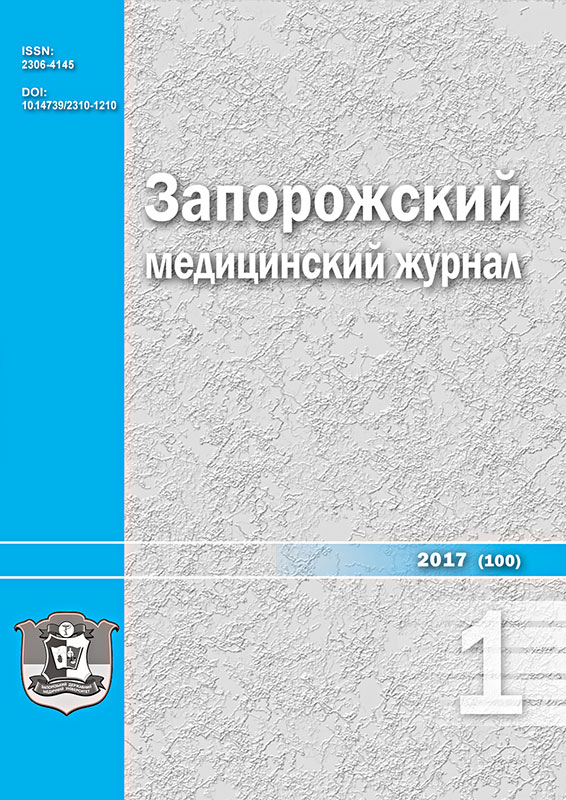Family Еnterobacteriaceae spp. antibiotic resistance as the main pathogen of the urinary tract infections among adult women
DOI:
https://doi.org/10.14739/2310-1210.2017.1.91713Keywords:
urinary tract infections, enterobacteriaceae, antibiotic resistanceAbstract
A growing antibiotic resistance among the pathogens of infectious and inflammatory diseases is an extremely serious problem in medicine and nephrology, in particular. Knowledge of urinary tract infections pathogens regional bacterial resistance is the «basis» of a differentiated approach to empirical antibacterial treatment as a pathogenetic treatment of this pathology.
The aim of the article is to determine the range and dynamics of the family Enterobacteriaceae antibiotic resistance as dominate among different groups of the urinary tract infections pathogens in adult women of the Chernivtsi region.
Materials and Methods. A retrospective analysis of the bacteriological examination of 396 urine samples of the Chernivtsi region adult women (2009–2013) was conducted with the purpose of the diagnosis “Urinary Tract Infections” (UTI) verification.
Results. 99 strains of the family Enterobacteriaceae (except Proteus) were extracted in etiologically significant quantities. The range of the extracted strains sensitivity to antibiotic medicine (antibiotics) was investigated. Temporal dynamic changes of the antibiotic resistance of Enterobacteriaceae as the pathogens of the urinary tract infections were analyzed.
Conclusions. Dynamics (2009–2013) of the family Enterobacteriaceae strains resistance (except Proteus) as the main pathogen of the urinary tract infections in women living in Chernivtsi region was largely dependent on the group of antibacterials and mostly characterized by «undulating» varied pattern.
Results of the study show that uropathogen E.coli extracted from the women living in this region retains sensitivity to penicillin series antibiotics (c2= 3.89; р < 0.05), fluoroquinolones (c2= 9.15; р < 0.01) and chloramphenicol (c2= 5.37; р < 0.05). A clear tendency to reduce antibiotic resistance strains of E.coli to cephalosporins of the 1st generation and presence of «undulating curve» resistance to cephalosporins of the 3rd generation is traced.
Regional microbiological monitoring makes it possible to analyze the spectrum of UTI pathogens and their sensitivity to antibacterial drugs, to take measures timely to prevent the development of uropathogen bacterial multiresistance and introduce modifications into local clinical protocols of UTI treatment in hospitals of the Chernivtsi region.
References
Kolesnyk, M., Stepanova, N., & Kruglikov, V. (2016). Etiolohichnyi spektr ta desiatyrichnyi patern antybakterialnoi rezystentnosti zbudnykiv neuskladnenoi infektsii sechovoi systemy (2005–2015 roky) [The etiological spectrum and antibiotic resistance pattern of bacteria causing uncomplicated urinary tract infections: a ten-year surveillance study (2005–2015)]. Ukrainskyi zhurnal nefrolohii ta dializu, 1(49), 32–41. [in Ukrainian].
Romanenko, O., Stepanova, N., Rudenko, A., Kruglikov, V., Lebid, L. & Kolesnyk, M. (2013). Osoblyvosti mikrobnoho spektru sechostatevoi systemy zhinok z retsydyvuyuchym piielonefrytom [Features of the microbial spectrum urogenital system of women with recurrent pyelonephritis]. Ukrainskyi zhurnal nefrolohii ta dializu, 1(37), 25–31. [in Ukrainian].
Feshchenko, Yu. I., Gumenuk, M. I., & Denisov, O. S. (2010). Antybiotykorezystentnist mikroorhanizmiv. Stan problemy ta shliakhy yii vyrishennia [Antibiotic resistance of microorganisms. state of problem and way of decision]. Ukrainskyi khimioterapevtychnyi zhurnal, 1–2(23), 4-10. [in Ukrainian].
Grabe, M., Bjerklund-Johansen, T. E., Botto, H., Çek, M., Naber, K. G., Pickard, R. S., et al. (2013). Guidelines on urological infections. European Association of Urology.
Rosner, B. (2003). Fundamentals of biostatistics. Belmont: Duxbury Press.
Downloads
How to Cite
Issue
Section
License
Authors who publish with this journal agree to the following terms:
Authors retain copyright and grant the journal right of first publication with the work simultaneously licensed under a Creative Commons Attribution License that allows others to share the work with an acknowledgement of the work's authorship and initial publication in this journal. 
Authors are able to enter into separate, additional contractual arrangements for the non-exclusive distribution of the journal's published version of the work (e.g., post it to an institutional repository or publish it in a book), with an acknowledgement of its initial publication in this journal.
Authors are permitted and encouraged to post their work online (e.g., in institutional repositories or on their website) prior to and during the submission process, as it can lead to productive exchanges, as well as earlier and greater citation of published work (See The Effect of Open Access)

